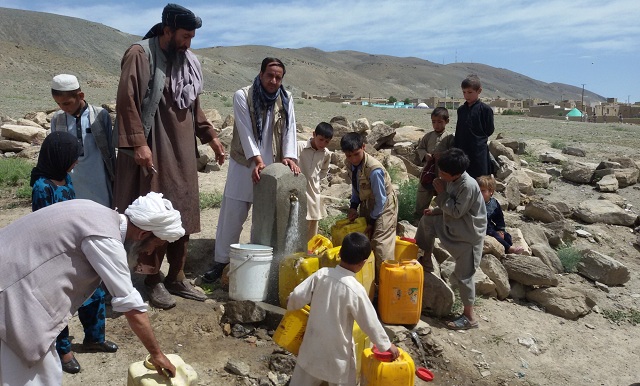Given growing water scarcity and pollution, increasing numbers of residents in Kabul city are struggling to provide enough safe water for their households. Many are forced to turn to the expanding private water business for their needs: eitherby paying for water from mobile water tankers, subscribing to local private water supply companies or buying bottled “mineral water.” Others incur travel costs to get water from public taps or pay for purifiers to filter contaminated water from their wells. The mushrooming private water business is expected to expand even further given the country’s changing water context as a result of climate change, population growth and government negligence in terms of prevention and regulation. AAN researcher Said Reza Kazemi presents his observations and conversations with households and water stakeholders. He concludes that if these challenges are not addressed, the implications of a potential water crisis are likely to be dire.
A changing water context
The water situation is changing in Afghanistan due to several factors: increasing population, the overexploitation and mismanagement of water resources, groundwater depletion and contamination, and climate change. These stresses can be strongly felt in the Kabul River Basin that feeds the city of Kabul and houses 35 per cent or around 8 million of Afghanistan’s population (see page 95 of this journal). Of these, about 4.5 million live in Kabul city alone and this is expected to increase to around 8 million by 2050. This makes Kabul the fifth fastest growing city in the world and among the world’s most water-stressed cities.
As a result, water issues facing Kabul inhabitants are manifold. First is the immense shortage of water. A study by the German development bank KfW has estimated Kabul’s groundwater potential to be about 44 million cubic metres per year (MCM/year) while the city’s water demand in 2015 was 123.4 MCM/year, revealing a striking imbalance between water availability and demand for water. This means that a large part of current demand for water is met from other sources, such as groundwater from aquifers in the Logar-Upper Kabul River Basin. At the same time, many people are left with little or no water. The Afghanistan Urban Water Supply and Sewerage Corporation (AUWSSC), the country’s water and sewage utility, has estimated that about 30 per cent of residents in Kabul city have access to piped water and only around 10 per cent of them receive potable water (see here, and page 49 of this report). Aggravated by climate change (read our recent dispatch here), groundwater in several parts of Kabul city has fallen by 20 metres in recent years (see also this media report). This has serious implications for the sustainability of water supply in the future because “the groundwater extraction rate is faster than the recharge rate” (see here).
Water in Kabul is not just scarce. It is also increasingly unsafe, especially for drinking, cooking and general household use. A team of BBC Persian journalists recently tested Kabul’s water in the Ministry of Rural Rehabilitation and Development (MRRD) laboratories (see their report here). They found at least 20 harmful bacteria in the 100 millimetres (mm) they sampled at two locations in western and northern parts of the city. Afghanistan’s National Environmental Protection Agency (NEPA) had earlier warned that 70 per cent of Kabul’s groundwater had been so contaminated with “pernicious chemicals and bacteria” that it had become “unusable”. Doctors at the Kabul-based Infectious Diseases Hospital have confirmed that in recent years, 70 per cent of their patients have fallen ill from drinking polluted water.
The AUWSSC, in a workshop in March 2018, linked the poor quality of Kabul’s groundwater to a “lack of civic awareness, excessive and unjust water extraction by the industrial sector and the leakage of wastewater from the household and industrial sectors” (see here). As examples of “unjust water extraction,” the AUWSSC cited excessive use of water from “water pumps, pools and car washing stations” across the city. To address this excessive, unsustainable water consumption, there are increasing calls for what has been described as “hydro-cognizance” or water knowledge in Afghanistan because water has received too little attention in the country. (1)
Two families and their quest for household water
Afghanistan’s water problems are felt most acutely at the household level within the family, particularly in rapidly growing urban centres such as Kabul. AAN spoke with members of two families who explained how the shortage and poor quality of water was affecting their lives and eating into their resources.
“Our electric pump is on from night to morning but the reservoir on our roof rarely gets filled,” the 65-year-old retired father of an extended, lower-middle-class family of 14 members living in the Darulaman area of Kabul city told AAN. He lives with two of his sons and their families in the same compound. He explained that this was caused by a combination of mounting water shortage in their well and low-voltage electricity in their alley in district 6 of Kabul city (like many households in Kabul, their primary water source was a well with an electric pump in their courtyard). He worried about what would happen if their well dried up, as digging a new well would be expensive and cost them around Afs 50,000 (approximately USD 714.29, if Afs 70 is exchanged for USD 1) as well as being an inconvenience. It may also be unsuccessful. A neighbouring family needed to dig a new well but had failed to find water, even though they dug deep in three locations in their courtyard, and were forced to abandon their house last year. There was then no other water supply source, public or private. That house remains abandoned.
Instead the family has been thinking of subscribing to a new private water supply company that has begun providing piped water to residents in parts of Darulaman, although not yet to their neighbourhood. This private supplier has dug a deep well of over 200 metres near Darulaman and installed the electrification, reservoir and piping system needed to pump water to households. Subscribing to this water supplier costs Afs 8,000 (USD 114.29) per house – a one-time expense – and the water is sold for Afs 30 (USD 0.43) per cubic metre. Given the desirable level of a minimum of 80 litres per capita per day (LPCD), this 14-member family would need at least 33.6 cubic metres of water per month, costing them Afs 1,008 (USD 14.4). This might not be a huge sum for a lower-middle-class family but it is a significant amount for economically poor and disadvantaged households, especially on rocky hills in and around the city where private water supply is more than twice as expensive.
For the last couple of years, the family has been boiling their well water to use as drinking water as well as buying it in heavy plastic water-cooler containers (19 litres for Afs 30 or USD 0.43 in their area). The young male members of the family carry these containers on their shoulders, or sometimes they put two or more of them in a wheelbarrow; it is impossible for the old or frail members of the family, such as the father, to do this. The family became especially concerned about the decreasing quality of groundwater in their area after one of the men in their family developed a stomach ulcer caused by the intestinal bacteria Helicobacter pylori (H. pylori). A relative of theirs living in the Kart-e Se area was infected with the intestinal illness amoebic dysentery and lost a lot of weight as a result.
The water problem affects men and women differently. In this family the father’s two married sons, both of whom are employed and have office jobs, are mostly responsible for paying for increasing water expenses and in some cases for bringing water home. The women, including the mother and the two daughters-in-law, shoulder other important responsibilities. They often plug in the electric pump when there is electricity and unplug it after many long hours for the reservoir to get filled. More significantly, any water shortage affects the women much more than the men. Less water means greater difficulty in attending to the kids, cooking, washing and house- and family-keeping in general, such as hosting relatives. At the same time, water-borne illnesses are becoming a serious family concern. Water-related problems are thus having an impact on the daily lives of Kabul households, particularly women’s.
Other parts of the city face similar issues. In Old Taimani, an area located in district 4 of the city, a middle-aged father responsible for an eight-member family of middle class status talked to AAN about the problems they had been having with the well in their house:
“Our well went dry a couple of months ago. We dug another well but it hit sand some 60 metres underground, making it difficult and unfit to dig deeper. So we stopped and have just begun digging another well in a different location, in front of the entrance to our house. We plan to dig some 100 metres. In the past, we used to reach water at about 40 metres, now it is at 60 metres, but we plan to go 40 metres deeper to get more groundwater. The whole thing including the well-diggers and plumbers, pipes and electrification will cost us about 60,000 afghanis [USD 857.14].”
The struggles faced by these two families are those of many residents in Kabul city, who try to provide their households with enough water that is safe to use and drink. For low-income families and the poor, getting water home is far more difficult. Access to clean water for household consumption has become a quest for everyone in the city, physically, financially and psychologically. But this quest is related to the wider context of access to water on a global scale, a context that has gradually, if not rapidly, turned domestic water supply into a business in urban centres like Kabul that targets families such as the ones quoted above.
Where do most households get their water?
Starting with the economically poor living in the suburbs and on the rocky hills of the city, many rely on public taps for their household water needs. According to AUWSSC estimates that have been confirmed by recent research, about 390 public taps in or near mosques, schools and public roads provide water for some 580,000 people. The water is free of charge, but difficult to fetch because the taps are often far from their homes. It usually falls on young children, often girls, to carry the water home in buckets and other containers, sometimes on donkeys or mules in some places. People of a slightly higher economic standing often use a rickshaw or car to fill their containers at the public taps and bring them home for domestic use. As the water is piped from AUWSSC-run well fields, (2) it is generally regarded as safe for drinking and cooking.
In areas of Kabul where economically poor and disadvantaged residents have no access to public taps, water is often supplied by small private companies operating water tankers that move from place to place, filling 200-litre barrels for about Afs 50 (USD 0.71). In some places, such as Khairkhana, a barrel of water is twice as expensive (i.e. Afs 100 or USD 1.43), as the area is situated on a hill and more difficult to access, a local told AAN. But there are questions about the cleanliness of this water.
Those who are better-off economically use other, easier options to supply their households with water. Over 60,000 houses are subscribers of a patchy public water supply system that provides piped water to specific areas of the city, according to AUWSSC spokesman Sayed Nawid Saeedi who talked to AAN. The rate for this supply of public water is fixed: Afs 25 (USD 0.36) per cubic metre. Because of water scarcity, most parts of Kabul city that are connected to the public water supply grid only have running water for a couple of hours per day or per couple of days. Residents told AAN they have to store water for use until the following day(s).
Many families with courtyards have dug their own wells ever deeper as the groundwater table has been descending (see also here). This has boosted the well-digging business in town, as people have begun digging wells of 100 metres and deeper, as referred to by the second family quoted above. The cost is around Afs 200–300 (USD 2.86–4.29) per metre, depending on the geological features of the soil, according to two well-diggers who talked to AAN.
Some families who have wells have also subscribed to public or private water supplies because water quality is better and more importantly they want to diversify their water sources. Others are using purifiers to filter their well water. Several companies have seized on this opportunity and now sell water purifiers in the city. To grow their business, they have resorted to expensive advertisements on local TV stations and billboards in well-off areas of the city. This author spoke to families in Kabul city who had bought American, Indian, Italian and Taiwanese water purifiers, costing between Afs 10,000 and 17,500 (USD 142.86 to 250.00).
With specific regards to potable water (see also page 75 of this report), many private companies have developed to provide “mineral water.” Vans deliver plastic water-cooler containers to embassies, companies and private homes in well-off areas of Kabul city, turning the supply of potable water into “a matter of money” (see here). The plastic water-cooler containers are also sold in shops for about Afs 300 each (USD 4.29) and the water in it for Afs 50 (USD 0.71) – this is astonishing because it is about ten times less and represents the cost of a 200-litre barrel of water provided by mobile water tankers in economically poor, disadvantaged neighbourhoods of the city. According to the Afghanistan Investment Support Agency (AISA) and the Environmental Health Directorate of the Ministry of Public Health (MoPH), there were 87 registered private mineral water supply companies in 2016, with 58 companies active in Kabul city alone. AUWSSC spokesman Saeedi provided even higher figures, stating that there were over 250 companies offering mineral water in Afghanistan, with most of them focused on the city of Kabul. Many of these companies have dug deep private wells in and around the city where they get their water. But there have been complaints about the quality, including the colour and taste of the water, and even reports that “discarded commercial water bottles … [were] being refilled from wells, resealed and sold as pure” (see here and here). The MoPH does some monitoring of mineral water supply companies and has, at least in one case, issued warnings to ten companies to improve their products.
A lack of regulation and a thriving private business
The lack of regulation of private water supply companies is an indication of a lack of coordination among the relevant Afghan government agencies in general. Several government agencies work in the area of water supply in Afghanistan, including the Water Affairs Regulation Directorate of the Ministry of Water and Energy (MEW), the Water Supply Directorate of the Ministry of Urban Development and Housing (MUDH), the NEPA, the AUWSSC and municipalities in urban centres such as the capital, Kabul, as well as the MRRD in rural areas. But coordination has been generally lacking, mainly because the growth of urban centres such as Kabul has simply overtaken the relevant authorities. AUWSSC spokesman Saeedi told AAN that their agency did not have the power to regulate or monitor the work of private water supply companies. This was corroborated by a former official from the MUDH Water Supply Directorate, who spoke to AAN on condition of anonymity and conceded that not only was there no overarching urban water policy within the Afghan government but that it lacked a single, national authority to monitor urban water supply and enforce applicable rules, notably the Water Law (e.g. see article 21 on licensing water supply, article 30 on addressing water pollution, article 35 on penalties for water offences and article 38 on digging deep wells here and an unofficial English translation here). (3) This was because, as the official said, “water is yet to become a priority for the government.”
The neglect and inactivity of the Afghan government has provided a space for private water supply companies to expand considerably. According to the AUWSSC spokesman, there are some 72 private companies supplying water to thousands of families across Kabul city. “They operate illegally. Their operation is substandard. They charge their subscribers as much as they can up to Afs 50 [USD 0.71] and even more per cubic metre of water. They extract groundwater which is a public good, charge people on the installation of pipes and then sell the water to the people,” stated AUWSSC spokesman Saeedi. Similarly, there have been calls for the regulation of private water supply companies that some have been accused of “having looted Kabul’s groundwater”. It is mostly because individuals and companies have been left free to dig very deep wells and extract groundwater depending on their financial means and political influence without any regulation by the government. Much of this groundwater extraction is aimed at selling water to residents or using the water in the manufacturing of beverages for sale in the marketplace. Several residents have told AAN that they have paid between Afs 10,000 and 30,000 (USD 142.86 to 428.57) to subscribe to private water supply companies and pay between Afs 30 and 80 (USD 0.43 to 1.14) per cubic metre of water. However, the government currently faces a fait accompli to regulate a private water business that has grown in a legal vacuum.
This author has taken a close look at one private water supplier in Kabul city. This supplier operates in Omid-e Sabz Township in district 6 of Kabul city. The officer in charge of water supply in this township, Mohammadpour, told AAN that around 1,700 households were their subscribers. The subscription fee is Afs 12,000 (USD 171.43) and each cubic metre of water costs Afs 35 (USD 0.5). To provide the water, they have dug five deep wells of 200–250 metres. They also use four tankers to add a daily amount of 300 cubic metres of water to add to their reservoir and then pipe the water to their subscribers. Given the daily consumption of 1,100 to 1,200 cubic metres of water in the township, the water supply company is not able to provide running water 24/7; they only provide water for about a couple of hours per day. Mohammadpour confirmed that his company and the private water supply companies he knew were not regulated or monitored by the government. One reason for the continued operation of companies such as Mohammadpour’s is that it is a beneficial business both for the subscribers that can provide their households with water where the public water supply is non-existent, and for suppliers. A similar business is run by the other 70-plus private water supply companies that operate in different parts of Kabul city.
Providing households in inaccessible areas with water is more difficult, such as those located on rocky hillsides in and around the city, a situation that exposes residents to potential exploitation by water suppliers. One local representative in Afshar, an area in district 5 of Kabul city, told AAN that local residents were having many problems with a demanding supplier that had been charging them more and more for supplying them with water. The fee for one cubic metre of water had risen from Afs 45 (USD 0.64) to Afs 80 (USD 1.14) in a couple of years, and the supplier had recently demanded a further increase of Afs 5 (USD 0.07). “Once the water supply system was installed, the supplier noticed we were in need and in a weak position, so he has kept asking us for more money for water. We’ve approached various authorities even the complaints handling section of the parliament but no one cared about us. So we’re left on our own to deal with our water problems,” said the local representative.
Projects and prospects
There are increasing pressures both internally and externally on the Afghan government to take the water issue and the broader effects of climate change more seriously. Most recently, on 14 August 2018, in an open dialogue organised by the Afghanistan Research and Evaluation Unit (AREU) and the EU Delegation in Kabul, the participants acknowledged “the importance of groundwater for Afghan livelihoods … and that the development and protection of groundwater has received too little attention in Afghanistan, in part because it is not well understood” (AREU Press Release, 16 August 2018, seen by the author). Days earlier, on 8 August 2018, the European Union (EU) held a dialogue with Afghan stakeholders in Kabul to highlight climate change impacts including the “reduction of underground waters”.
There are also indications that the Afghan government has started working on the water issue, but very few practical outcomes have been achieved thus far. For the waters that flow into neighbouring countries, the MEW has made the construction of hydropower dams a priority – a vision promoted by President Ashraf Ghani – that has raised concerns in countries such as Iran. (4) For the water supply to Kabul city specifically, the Afghan government has several projects, mostly under study, including the Shahtoot dam, the Panjshir Fan Aquifer, the Panjshir River, and the two storage dams of Gulbahar and Salang. Hopes have particularly been pinned on the Shahtoot dam that can store 147 MCM of water and provide for about two million residents in Kabul city, as well as for 400 hectares of agricultural land in the Charasiab and Khairabad districts of Kabul province. There is also the Shah-Arus dam, which is under construction by the MEW and aims to provide water for residents in district 17 of Kabul city as well as for small agricultural purposes. In addition, the Asian Development Bank (ADB) is running the Managed Aquifer Recharge (MAR) pilot project that theoretically aims to help “stabilize or raise groundwater levels, improve the supply and quality of potable water and making Kabul urban water supplies more drought resistant and reduce the risk of land subsidence” (see here).
But the operationalisation of these projects is challenging for various reasons. The important Shahtoot dam will take at least three years to be constructed and its construction has yet to start. It is currently going through an environmental and social impact assessment. It also needs a huge upfront cost, if no other obstacles emerge. The former MUDH official quoted above said that the budget would be provided by several sources, particularly India, and this raises serious concerns for downstream Pakistan not just because of regional rivalry but also due to the decreased downstream flow of water (see also here). Four other potential water sources – the Panjshir Fan Aquifer, the Panjshir River, and the two storage dams of Gulbahar and Salang – are mainly alternative options under consideration by the Afghan government, meaning that there has been almost no practical work to implement them. One reason is that they are economically hugely unfeasible. The next – Shah-Arus dam – is a small water source mainly intended to provide water for one specific district in Kabul city as well as for small agricultural purposes. The MAR is a pilot project whose success is yet to be seen. In addition to the time required for these dams (several years in most cases), economic feasibility and their ability to address urban water supply needs in the Afghan capital, there are political and security considerations — not just overall, but specific to each project, their completion, administration and maintenance. These considerations in part stem from potential reactions of the downstream state of Pakistan to projects such as the Shahtoot dam that is financed by its archenemy India and will limit water flow into Pakistan. All these make the full implementation of these projects unlikely.
From a climate change perspective, even if the Afghan government became more active in addressing water issues in Kabul city and across the country by seriously implementing the aforementioned projects, as well as others, it could still fail to rise to the challenge given the severity of climate change effects on Afghanistan, the wider region and even the world beyond. But this is no reason for the government to do nothing about the problem, which is its current default modus operandi with regards to the issue.
The Afghan government has also been considering the provision of sewage services in cities like Kabul. Kabul city currently lacks a central sewage system and relies mainly on a system of individual septic tanks that are often situated close to water wells. The leakage of sewage into groundwater is considered a main cause of water contamination in urban centres such as Kabul and Herat. (5) According to the AUWSSC spokesman, changes are to be made in the Water Law and the Municipalities Law, requiring any construction license to provide water supply and sewage services as a condition. The intention is to treat wastewater and use it to water green areas in the city, for instance. The AUWSSC has established a new Directorate of Sewage Affairs and has so far designed sewage systems for 28 ministries and 15 government agencies in Kabul, but nothing has been implemented yet.
Several Kabul residents told AAN about the urgency of the water issue. “The main problem is that no one is working to tackle water issues. It is not only the government but also the public that should do their part in solving water problems,” said a long-time real estate agent familiar with the city’s water and housing issues. He further said that good water availability was turning into a major consideration when families decide to relocate to other parts of the city.
Kabul city faces severe water problems that are most intimately felt by its households. If the water issues are not addressed, they could lead to a full-blown water crisis with significant social ramifications, such as increased public health problems, dissatisfaction and even unrest. One thing that could help improve the dire situation is for the government to enhance its regulation of groundwater extraction and private water supply industry. An expanding, well-managed public water supply can help ensure better and greater access to water by the public, both poor and rich, and thereby contribute to public trust in the way the country is governed. This could happen if the Afghan government treats water as a priority, creates an effective and efficient institutional arrangement to implement and enforce it and engages in meaningful cross-border negotiations with affected downstream states. The people should also certainly do their part by increasing their water awareness and consuming water in a sustainable manner for their own and their children’s needs. Otherwise, families will have to resort to expensive private water supply businesses or continue digging deeper to provide their households with water, further depleting and contaminating crucial groundwater resources.
Edited by Martine Van Bijlert and Sari Kouvo
(1) Shroder and Ahmadzai, for instance, have called for water education for sustainable development at all levels of education in Afghanistan, from the primary to the technical hydrologic levels. They have presented a multiple perspectives approach for water education including eight major perspectives: (1) scientific, (2) historical, (3) geographic, (4) human rights, (5) gender equality, (6) values, (7) cultural diversity and (8) sustainability. See John F Shroder and Sher Jan Ahmadzai (2017) “Hydro-Cognizance: Water Knowledge for Afghanistan,” Journal of Afghanistan Water Studies, Volume 1, Issue 1, Kabul: Duran Research and Analysis: pages 23-58.
(2) The AUSSWC operates the three major well fields in Logar, Alauddin and Afshar that are respectively located close to the Logar, Kabul and Laghman rivers.
(3) Afghanistan’s Water Law has been criticised for being too far removed from reality. For instance, research shows that its provisions on “permits and licences are not implementable within or even useful for the traditional irrigation systems, but mainly play into the hands of the national hydrocracy and please international donors.” See Kai Wegerich (2010) “The Afghan water law: ‘a legal solution foreign to reality’?” Water International, 35(3), 298–312. An AREU paper calls for compromises between international practices and local preferences that lead to agreements on practical water governance.
(4) For the cross-border implications of Afghanistan’s water issue, see Vincent Thomas with Mujib Ahmad Azizi and Khalid Behzad (2016) “Developing transboundary water resources: What perspectives for cooperation between Afghanistan, Iran and Pakistan?,” Kabul: Afghanistan Research and Evaluation Unit (AREU) and Duran Research and Analysis (2017) Journal of Afghanistan Water Studies, Volume 1, Issue 1, Kabul: Duran Research and Analysis. Duran Research and Analysis has also developed a rich and useful knowledge base on Afghanistan’s waters, especially their cross-border aspects. See Afghanistan Waters Portal.
(5) Similar water problems exist in Herat city. Groundwater has gone down some 7–12 metres and been polluted in this western urban centre. Source: Hasht-e Sobh daily newspaper, 16 Asad 1397/7 August 2018, page 8.
By Special Arrangement with AAN. Original link.
Disclaimer: Views expressed on this blog are not necessarily endorsed or supported by the Center for Research and Security Studies, Islamabad.








